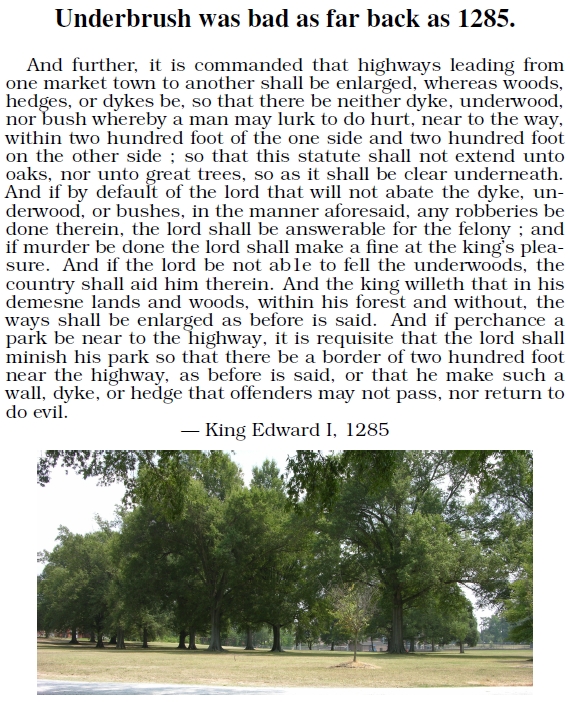5. 6 Underbrush in 1285
 Figure 5.6: A section of the 1285 Statute of Winchester concerns the dangers of vegetation as a hiding place for evildoers (Adams and Stephens 1901, p. 78). “Demesne” means, essentially, domain, and “minish” is the same as diminish or reduce. The photograph shows a scene from Duke University’s East Campus that lives up to King Edward I’s ideal, with underbrush removed and “great trees” limbed for long sightlines.
Figure 5.6: A section of the 1285 Statute of Winchester concerns the dangers of vegetation as a hiding place for evildoers (Adams and Stephens 1901, p. 78). “Demesne” means, essentially, domain, and “minish” is the same as diminish or reduce. The photograph shows a scene from Duke University’s East Campus that lives up to King Edward I’s ideal, with underbrush removed and “great trees” limbed for long sightlines.
For some reason, people think that vegetation protects criminals, harboring unknown dangers for the innocent, and this sense of danger goes way back. The 1285 Statute of Winchester[21] reveals that the idea that vegetation protects the crimimal has been around for a very long time (see Figure 5.6). The list of disliked features in Figures 5.4 and 5.5 included this fear, along with cluttered and not kept up; the converse, “looks safe,” along with trimmed and kept up, showed up on the list of liked features. Whether or not this statute from 1285 has any bearing, perhaps filtered through the style of English campuses designed centuries ago, Durham’s East Campus of Duke University sets back its great oaks far from streets and walking paths, trimmed perhaps to reveal any offenders therein.
Is this fear of vegetation justified?[22] Eight hundred years ago criminals could run up to slow-moving carriages, but today’s criminal-crunching cars weaken those fears. Certainly, bad (and good) people can hide behind many things, trees as well as parked cars, alleyways, brick walls, fences, shrubs, poles, thick grass, and dark hallways.[23] Would urban citizens’ quality of life be better with empty, tree-free parking lots and highly urbanized areas, with roads cleared 200 feet on either side? We’ve already examined health issues relating to urban heating caused by replacing trees with parking lots. Bringing nature back into the city might alleviate those problems, and the remainder of this chapter considers whether having it directly promotes or hinders our safety and health. Whether or not King Edward’s fear is justified today, it exists, and promoters of city vegetation must deal with the trade-off between the messiness of truly natural ecosystems and people’s desires for trimmed trees without brush or sticks (perhaps motivated by perceived dangers).
Only a relative handful of studies examine these essential sociological questions. Descriptive examples exist in the social sciences literature regarding the fear of crime, or danger in general, but many lack quantitative analyses.[24] These examples include studies that rate the safety of parking lots and show that perceived danger increases with the amount of vegetation. Perhaps that perception explains a situation like the tree-free case of the Northgate parking lot (see Figure 2.12). Perhaps there is some basis to the fear. Interviews with informants concerning auto burglaries in Washington, D.C., for example, confirmed that criminals use available trees and vegetation to their advantage in a criminal act. Importantly, however, the commitment of the criminal act didn’t depend on the presence or absence of trees and vegetation; rather, criminals just modified their behavior in the absence of vegetation.[25]
—————————-
[21]I initially happened upon the 1285 Statute of Winchester quote, in a shortened form, in Kuo and Sullivan (2001a), within which they examine the connections between crime and vegetation. The shortened form makes the statute seem much more severe, but the earlier quote shows deeper concern only with underbrush.
[22]Brundson et al. (1995) discuss some of these fear-of-vegetation issues, disputing simplistic ideas that removing vegetation reduces crime.
[23]A U.S. Bureau of Justice Statistics bulletin by Catalano (2006) provides an excellent summary of crime experienced by Americans.
[24]Kuo and Sullivan (2001a) provide a fascinating overview of studies linking fear of crime and vegetation.
[25]Michael et al. (2001) surveyed informants regarding auto burglaries and the role vegetation played.